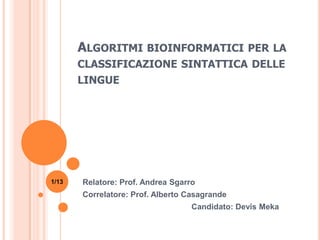Presentazione meka
•Als PPTX, PDF herunterladen•
0 gefällt mir•492 views
Melden
Teilen
Melden
Teilen

Empfohlen
Empfohlen
Weitere ähnliche Inhalte
Empfohlen
Empfohlen (20)
Product Design Trends in 2024 | Teenage Engineerings

Product Design Trends in 2024 | Teenage Engineerings
How Race, Age and Gender Shape Attitudes Towards Mental Health

How Race, Age and Gender Shape Attitudes Towards Mental Health
AI Trends in Creative Operations 2024 by Artwork Flow.pdf

AI Trends in Creative Operations 2024 by Artwork Flow.pdf
Content Methodology: A Best Practices Report (Webinar)

Content Methodology: A Best Practices Report (Webinar)
How to Prepare For a Successful Job Search for 2024

How to Prepare For a Successful Job Search for 2024
Social Media Marketing Trends 2024 // The Global Indie Insights

Social Media Marketing Trends 2024 // The Global Indie Insights
Trends In Paid Search: Navigating The Digital Landscape In 2024

Trends In Paid Search: Navigating The Digital Landscape In 2024
5 Public speaking tips from TED - Visualized summary

5 Public speaking tips from TED - Visualized summary
Google's Just Not That Into You: Understanding Core Updates & Search Intent

Google's Just Not That Into You: Understanding Core Updates & Search Intent
The six step guide to practical project management

The six step guide to practical project management
Beginners Guide to TikTok for Search - Rachel Pearson - We are Tilt __ Bright...

Beginners Guide to TikTok for Search - Rachel Pearson - We are Tilt __ Bright...
Presentazione meka
- 1. ALGORITMI BIOINFORMATICI PER LA CLASSIFICAZIONE SINTATTICA DELLE LINGUE Relatore: Prof. Andrea Sgarro Correlatore: Prof. Alberto Casagrande Candidato: Devis Meka 1/13
- 2. PROBLEMA: CLASSIFICAZIONE DELLE LINGUE INDO-EUROPEE CONTEMPORANEE USANDO GLI ALGORITMI BIOINFORMATICI. Vari studi linguistici per fare una classificazione delle lingue basandosi sui parametri sintattici, usando gli algoritmi bioinformatici. Confronto tra i metodi basati sui caratteri e i metodi basati sulle distanze, ricostruendo alberi filogenetici. Confronto tra le distanze di Hamming e le distanze fuzzy di Hamming come misure di divergenza tra le lingue. 2/13
- 3. ALGORITMI BIOINFORMATICI 1) Metodi basati sui caratteri: Prendono in input una matrice di caratteri discreti. Massima Parsimonia Algoritmo di Hendy e Penny Compatibilità Massima Verosimiglianza 2)Metodi basati sulle distanze Prendono in input una matrice con le distanze tra tutte le coppie delle entità. Neighbor-Joining (NJ) Unweighted Pair Group Method with Arithmetic Mean (UPGMA) 3/13
- 4. MASSIMA PARSIMONIA 4/13 Problemi: Le lingue Germaniche vengono fuse con le lingue Celtiche. I dialetti Italiani vengono raggruppati insieme ai dialetti Greci ed il Greco. Possibili cause: Condivisone di un certo numero di parametri sintattici. Il numero dei parametri abili a distinguere i sottogruppi è ridotto.
- 5. MASSIMA PARSIMONIA ALGORITMO DI HENDY-PENNY 5/13 Problemi: La classificazione del Rumeno con i dialetti Greci ed il Greco. Possibile cause: Il Rumeno è la lingua più esterna al sottogruppo delle lingue Latine. Condivide un grande numero di parametri con i dialetti Greci.
- 6. METODO DI MASSIMA VEROSIMIGLIANZA 6/13 Problemi: Le lingue Germaniche vengono mischiate con le lingue Celtiche. In questo gruppo viene aggiunta anche la lingua Farsi. Possibili cause: Le lingue Germaniche condividono un certo numero di parametri con quelle Celtiche. L’attrazione dei rami lunghi.
- 7. UPGMA SULLE DISTANZE DI AMMINA 7/13 UPGMA dà i risultati più soddisfacenti. Assume che il tasso di evoluzione tra tutte le lingue sia uguale o quasi. Ricostruisce un albero binario e con radice.
- 8. NJ SULLE DISTANZE DI HAMMING 8/13 Problemi: Le lingue Germaniche vengono raggruppate con le lingue Celtiche. La posizione errata del Bulgaro. Possibili cause: NJ non fa una classificazione accurata quando il tasso di evoluzione è uguale.
- 9. UPGMA SULLE DISTANZE FUZZY DI HAMMING 9/13 Problemi: Il Bulgaro e viene raggruppato con le lingue Germaniche. Possibili cause: La distanza fuzzy di Hamming avvicina il Bulgaro con le lingue Germaniche.
- 10. NJ SULLE DISTANZE FUZZY DI HAMMING 10/13 Problemi: La classificazione errata del Bulgaro. La fusione dei dialetti Greci con le lingue Latine. Possibili cause: L’attrazione tra il Rumeno ed il Bulgaro e la posizione esterna del Bulgaro.
- 11. CONFRONTO TRA NJ E UPGMA 11/13 NJ non usa direttamente la matrice delle distanze ma ne ricostruisce un’altra. UPGMA unisce al primo passo il Rumeno con le lingue Latine, mentre NJ unisce il Rumeno con i dialetti Greci.
- 12. CONCLUSIONI I metodi basati sulle distanze si comportano meglio dei metodi basati sui caratteri, quando si vuole fare una classificazione basata sui parametri sintattici. Le distanze fuzzy di Hamming non rappresentano correttamente le vere distanze tra le lingue. L’algoritmo UPGMA fa una ricostruzione più accurata rispetto al NJ. 12/13